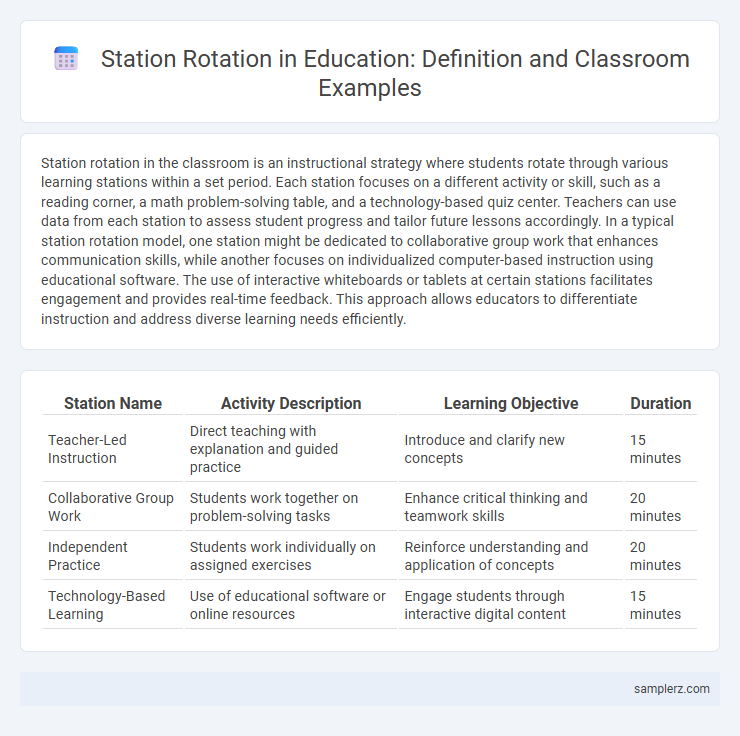Station rotation in the classroom is an instructional strategy where students rotate through various learning stations within a set period. Each station focuses on a different activity or skill, such as a reading corner, a math problem-solving table, and a technology-based quiz center. Teachers can use data from each station to assess student progress and tailor future lessons accordingly. In a typical station rotation model, one station might be dedicated to collaborative group work that enhances communication skills, while another focuses on individualized computer-based instruction using educational software. The use of interactive whiteboards or tablets at certain stations facilitates engagement and provides real-time feedback. This approach allows educators to differentiate instruction and address diverse learning needs efficiently.
Table of Comparison
| Station Name | Activity Description | Learning Objective | Duration |
|---|---|---|---|
| Teacher-Led Instruction | Direct teaching with explanation and guided practice | Introduce and clarify new concepts | 15 minutes |
| Collaborative Group Work | Students work together on problem-solving tasks | Enhance critical thinking and teamwork skills | 20 minutes |
| Independent Practice | Students work individually on assigned exercises | Reinforce understanding and application of concepts | 20 minutes |
| Technology-Based Learning | Use of educational software or online resources | Engage students through interactive digital content | 15 minutes |
Introduction to Station Rotation in Modern Classrooms
Station rotation in modern classrooms involves students cycling through several distinct learning stations, each designed to target different skills such as reading, writing, and technology use. This method enhances personalized learning by allowing teachers to tailor instruction to small groups, increasing student engagement and interaction. Effective implementation includes a blend of digital tools, collaborative tasks, and individual practice, ensuring comprehensive skill development.
Key Benefits of the Station Rotation Model
The station rotation model in the classroom enhances student engagement by allowing learners to rotate through various learning modalities such as collaborative projects, individualized instruction, and digital activities. This approach supports differentiated instruction, meeting diverse student needs through tailored pacing and content adaptation. Improved classroom management and increased opportunities for formative assessment are key benefits that contribute to effective learning outcomes.
Designing Effective Station Rotation Activities
Designing effective station rotation activities involves creating diverse, targeted tasks that address varied learning styles and skill levels, such as interactive math problems, reading comprehension drills, and collaborative science experiments. Each station should include clear instructions and measurable objectives to keep students engaged and ensure focused skill development. Integrating technology tools like tablets or learning apps enhances interactivity and provides immediate feedback, optimizing learning outcomes in a classroom setting.
Sample Station Rotation Schedule for Elementary Students
A sample station rotation schedule for elementary students typically includes four 15-minute stations: teacher-led instruction, collaborative group work, individualized technology activities, and hands-on learning centers. These rotations promote differentiated learning by allowing students to engage with content at varied levels of support and interaction. Implementing this schedule enhances student engagement, facilitates formative assessment, and supports diverse learning styles in elementary classrooms.
Example of Station Rotation in a Math Classroom
A math classroom using station rotation divides students into small groups rotating between different focused activities such as problem-solving at a whiteboard, interactive digital math games on tablets, and teacher-led instruction for targeted skill practice. This model enhances engagement by offering varied learning modalities like collaborative tasks, individual practice, and immediate feedback. Research shows station rotation improves mastery of concepts like fractions and algebraic thinking by scaffolding instruction through diverse, hands-on experiences.
Implementing Literacy Stations for Reading Success
Implementing literacy stations for reading success involves dividing the classroom into distinct areas, each dedicated to specific literacy skills such as phonics, vocabulary, and comprehension. Students rotate through stations engaging in activities like guided reading, word sorting, and interactive storytelling, allowing personalized learning and targeted skill development. This station rotation model promotes differentiated instruction and increases student engagement by catering to diverse reading levels and learning styles.
Technology Integration in Station Rotation
Station rotation in classrooms integrates technology by assigning students to different digital learning hubs, such as tablets for interactive exercises, computers for research, and collaborative software for group projects. This method enhances individualized learning pace and immediate feedback through educational apps like Khan Academy and Google Classroom. Teachers use real-time data from these platforms to tailor instructional strategies and boost student engagement effectively.
Differentiation Strategies Using Station Rotation
Station rotation in the classroom facilitates differentiation by allowing students to engage with tailored activities at various learning stations, such as individualized reading groups, targeted math problem-solving tasks, and interactive technology-based lessons. This strategy addresses diverse learning styles and proficiency levels by providing varied instructional methods within a structured framework. Data-driven grouping and real-time assessment at each station enhance personalized learning outcomes and support academic growth for all students.
Assessment Methods in a Station Rotation Setup
In a station rotation setup, assessment methods include formative techniques such as quizzes, observation checklists, and peer evaluations at different stations to gauge student understanding in real-time. Digital tools like tablets or learning management systems enable immediate feedback and data collection, enhancing personalized instruction. This approach promotes continuous assessment, allowing teachers to adjust activities based on student performance within each learning station.
Overcoming Common Challenges in Station Rotation
Effective implementation of station rotation in classrooms tackles challenges such as uneven student engagement by designing tasks aligned with diverse learning styles and allowing flexible timing to accommodate various paces. Integrating technology tools like adaptive learning platforms supports personalized instruction, ensuring all students remain motivated and on track. Continuous teacher monitoring and formative assessments help identify and address gaps promptly, enhancing the overall success of the station rotation model.

example of station rotation in classroom Infographic
 samplerz.com
samplerz.com